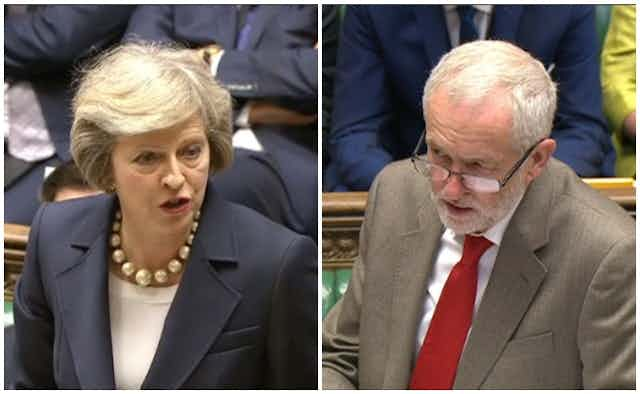At the beginning of the UK general election campaign it looked as if it might be the most lop-sided contest since 1945. Polls showed the Labour party lagging behind the Conservatives by between 16 and 22 points, a level of Tory supremacy that – even according to those pollsters that showed the narrowest margin – surpassed their landslide victory in 1983, when the Conservatives won by 15 points (42.4% of the popular vote to Labour’s 27.6%).
After the second week of the campaign all the polling companies – ComRes, ICM, Kantar, Opinium, ORB, Survation and Yougov – reported numbers that added up to what the renowned psephologist David Butler has called the biggest poll shift in any election campaign since 1945. The Conservative lead was cut dramatically to between 5 and 14 points. This has since narrowed further to a lead of between one and 12 points.
While this range could still give the Conservatives a comfortable majority, it opened up a possibility that was unthinkable at the beginning of the campaign – the idea that the government could lose its overall majority.
We have also seen a dramatic shift in the perception of the party leaders. Before the campaign, polls showed strong approval ratings for Theresa May’s party leadership and very negative ratings for Jeremy Corbyn. By May 25-26 YouGov reported a narrowing of the gap between them, but May still had a positive rating of +9 while Corbyn’s was -28 (a 37 point gap in favour of May). But by June 1-2, Corbyn’s rating had actually moved slightly ahead of May’s (Corbyn -2 to May’s -5).
Anyone familiar with research about the complex relationship between media coverage and public opinion will know that significant changes in public perceptions generally take place over a much longer period. So whatever the result on Friday morning, how do we explain this remarkably rapid shift?
Shifting focus
Part of the explanation is that Corbyn’s team have run a better campaign than May’s. But it is underpinned by broadcast news coverage that is bound by a public service ethos. As Loughborough’s research shows, press coverage in this campaign has been overwhelmingly anti-Labour and broadcasters have by no means given Labour an easy ride. But their statutory obligation to impartiality means that they have done what news providers are supposed to do in a democracy, and given both sides roughly equal time to make their case.
The teams monitoring the campaign at both Cardiff and Loughborough found Labour receiving roughly equal coverage from week two – the week that precipitated Labour’s biggest poll surge. While some of this was negative – based on judgements about the leaking of Labour’s manifesto, for example – it also became more policy oriented.

This has given a number of policies in Labour’s manifesto – policies polls suggest are popular with a majority of the electorate – significant airtime. This was arguably the first time since Corbyn became leader that Labour had received as much coverage as the Conservatives on policy issues – in a way that allowed both sides to set out their stalls.
And there’s the rub – whatever the merits of the two campaigns, what was striking was the contrast with a year’s worth of negative coverage of Corbyn and relatively positive coverage of May. In this context, Labour has outperformed expectations, while the Conservative leader struggled to live up to a campaign premised on her much-heralded leadership qualities.
History of bias
This does raise questions about the impartiality of media coverage over the preceding year. Veteran broadcaster David Dimbleby is the latest to criticise media coverage of Labour under Jeremy Corbyn – both for its right-wing bias and its “lazy pessimism” about Corbyn’s viability as a potential prime minister.
Press bias against Corbyn has been both predictable and overt. But the BBC has also been criticised for lapses in impartiality. In January, for example, the BBC Trust reprimanded the BBC’s political editor Laura Kuenssberg for editing an interview with Corbyn on the six o’clock news in ways that gave a false and negative impression of Labour’s leader.
This is not a matter of wilful bias by the broadcasters, who are genuinely committed to impartiality – but it does show how news judgements are not politically neutral. For the past two years, politics has been dominated by the ability of the two main party leaders to control their parties. By this measure, May clearly beats Corbyn. While this is an important and legitimate issue, its primacy in political reporting meant that insufficient attention has been paid – until now – to the very real policy choices that impact peoples’ lives.
It has also meant that the Conservative party’s economic record has received remarkably little serious scrutiny. In a series of articles, Oxford University economist Simon Wren-Lewis describes how Conservative claims about their “strong and stable” management of the economy have been replicated rather than questioned. This is in spite of a wealth of data suggesting that the government’s austerity policy has, by many measures, hindered economic growth. It has produced the slowest economic recovery on record – a worse record on GDP per capita growth than any previous Labour government and a stagnation on earnings that puts the UK behind every wealthy country other than Greece.
At the beginning of the campaign, both the Cardiff and Loughborough studies showed the Conservative party dominated coverage, with a focus on “leadership” rather than policy. This suited a Conservative party campaign based on promoting May’s leadership qualities and denigrating Corbyn’s. The polls only began to move when broadcasters became more balanced and policy-focused.
This exposure may have changed some public perceptions, but the residual impact of a year’s worth of coverage – that gave us “strong and stable” versus “coalition of chaos” – is likely to remain. While this narrative looks decidedly less secure than it did, it will probably be enough to secure the Conservative party victory.

